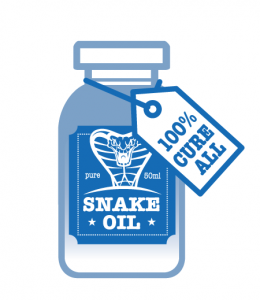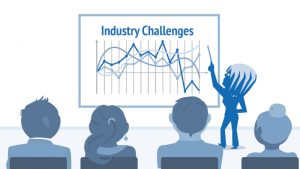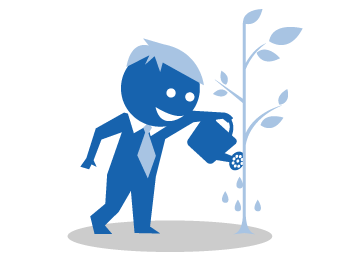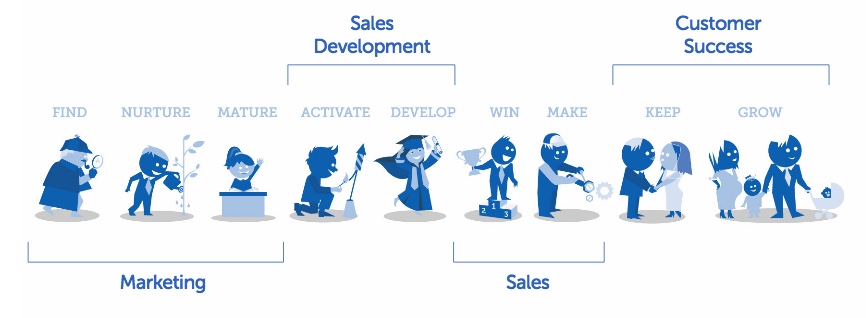Revenue Generation: Facilitating the Buyers’ Journey – Part 5
 Download this series of posts as an ebook.
Download this series of posts as an ebook.
Companies lie or at least they promise way more than they can deliver. Do you trust advertisements? Do you believe what companies say about themselves and their products/services?
I don’t, you don’t and your potential customers don’t.
In an era where the price of communication has dropped the volume of propaganda has increased correspondingly. Our customers are more careful than ever when they venture to find solutions for their needs, challenges and opportunities.
At the same time our industry is constantly developing improvements and inventing completely new value propositions that our customers can benefit greatly from if they only knew about them.
Read Part 1
Read Part 2
Read Part 3
Read Part 4
In this post I will briefly review each step in the revenue generation process. I have included a recommended reading list at the end of the post where you can get more inspiration and practical advice for each of the steps.
 Find
Find
![]() There are basically two options here:
There are basically two options here:
- Potential customers find you
- You find potential customers
In the information technology industry, both of these options must work.
Potential customers find you (inbound lead generation)
If you are never found by any of your potential customers, then you have either failed to complete the business development process or there is something terribly wrong with your marketing machine.
Being found requires two conditions to be fulfilled:
- You are present where your potential customers go
- Your messages ignite their curiosity
Your potential customers search the web, visit their bookmarked websites, go to conferences, read newspapers and magazines, pass billboards when traveling, watch television and go to the movies, listen to the radio, talk to their friends and associates and use social media. You must choose those venues where you can ignite their curiosity at the lowest possible cost of engagement. This combination of venue and message can be really hard to get right, so you need to learn from others before you then experiment.
 Let’s say that you decide to be present at a conference/exhibition where you know that many of your potential customers will show up. Can you find out who could attend and then invite them to come and see you? Can you issue a press release highlighting your presence and the type of solutions you will present? Can you include a message at the end of all the emails you submit four weeks prior to the conference? Can you post messages (organic and sponsored) on social media pointing to the issues you are ready to discuss at the conference? Can you have a promotion on your home page motivating visitors to book a meeting? Can you design your booth so that it is very easy for the casual visitor to understand what you do and stop to hear more? Can you prepare material, provide facilities and train your people to engage your visitors? Can you get on the podium and deliver a keynote on important industry challenges and how to deal with them? Can you prepare how you will follow up on the leads that you generate?
Let’s say that you decide to be present at a conference/exhibition where you know that many of your potential customers will show up. Can you find out who could attend and then invite them to come and see you? Can you issue a press release highlighting your presence and the type of solutions you will present? Can you include a message at the end of all the emails you submit four weeks prior to the conference? Can you post messages (organic and sponsored) on social media pointing to the issues you are ready to discuss at the conference? Can you have a promotion on your home page motivating visitors to book a meeting? Can you design your booth so that it is very easy for the casual visitor to understand what you do and stop to hear more? Can you prepare material, provide facilities and train your people to engage your visitors? Can you get on the podium and deliver a keynote on important industry challenges and how to deal with them? Can you prepare how you will follow up on the leads that you generate?
Just showing up at the conference and winging it will not give you the best return on your investment and that goes for all investments in activities aimed at generating inbound leads.
Being at the right place (where your potential customers hang out) with the wrong messages (typically propaganda about your company and your products) is not going to work. Being at the wrong place (where your potential customers do not hang out) with the right messages (related to the jobs, pains and gains you address) will not work either. Nailing the combination of right venue and right messages is key.
It takes thinking, help from others and experimenting.
You find potential customers (outbound lead generation)
Although the “inbound movement” will claim that outbound lead generation is a thing of the past, most companies in the information technology industry still experience a need for reaching out and knocking on the doors of their potential customers.
When you have completed the business development process, then you know exactly what your ideal customers look like. You know which type of companies they work for and what type of job functions they have. You can buy a list with their names and telephone numbers, you can search the web and find their web sites and you can most likely do an advanced search on LinkedIn and find all of them with their full profiles.
The challenge is that the statistical probability that they are interested in your product and your company is extremely low. Engaging with propaganda will kill this fragile moment.
Outbound lead generation for B2B information technology based solutions should exploit the opportunities provided by social media; an approach that over the recent years has been coined as “Social Selling[1].”
Nurture
 Just because someone has found you or you have found someone (with a pulse) doesn’t mean that they will become a customer tomorrow.
Just because someone has found you or you have found someone (with a pulse) doesn’t mean that they will become a customer tomorrow.
The analysis we did in Blog Post 1 indicates that they are not interested in us at all, but rather looking for inspiration and hope to find some with us. Let’s not kill this new, little, fragile relationship with the poison of propaganda.
Show a caring attitude and continue to provide genuine value before asking for meetings or dumping your promotional pitches in their inboxes or on their voice mails.
Mature
 Maturing means converting anonymous visitors or names on a list into active followers.
Maturing means converting anonymous visitors or names on a list into active followers.
We now have a name, an e-mail and maybe a phone number and this is where most companies release their packs of sales wolves on these poor, innocent souls, but I recommend to hold the horses. Just become someone leaves their email in return for a download, answers their phone or even returns your call doesn’t mean that they are ripe for your propaganda.
Understand the customer first and then keep providing genuine value in terms of contextual content that help your leads learn more about dealing with the pains that come with their jobs. Become the source they keep returning to for more insight.
See how people subscribe to your YouTube channel, download your e-books and whitepapers, sign up for your newsletters, follow you on Twitter, LinkedIn, Facebook etc. and invite you to connect on LinkedIn. Watch the traffic and when the activity picks up you may pass them to sales development.
Activate
 There are two reasons why you should be very cautious with premature attempts of activation:
There are two reasons why you should be very cautious with premature attempts of activation:
- You scare people away
- You are wasting your own time and resources
Throwing poisonous propaganda at your leads is a foolproof way of achieving both at the same time, but even a “how can I help you?” driven approach may be a waste of time and resources. How much you can invest in activating a mature lead obviously depends on the expected customer lifetime value. The higher the value they bring, the more you are prepared to invest, but qualify carefully and assign resources according to an objective scorecard approach.
Develop
 While the responsibility for the stages find, nurture, mature and activate normally resides with the marketing and the sales development people the handover to sales takes place when we have deemed that a lead is ready to be developed to become a genuine customer.
While the responsibility for the stages find, nurture, mature and activate normally resides with the marketing and the sales development people the handover to sales takes place when we have deemed that a lead is ready to be developed to become a genuine customer.
The development stage is highly customized and situational and thus requires substantial investments. Keep qualifying and be prepared to return the lead to marketing or sales development if too many red flags show up.
Win
 When potential customers reach the final mile of their purchase process, then we are working hard to avoid the two out of the three potential outcomes:
When potential customers reach the final mile of their purchase process, then we are working hard to avoid the two out of the three potential outcomes:
- They decide to do nothing (favoring another investment and/or postponing the investment in our solution)
- They go with a competitor
Navigating the final mile of the purchase process is always a balance of investing more resources or pulling out to avoid further expense on something that has a low probability of closing.
Make
![]() Do you recall the “land and expand” strategy?
Do you recall the “land and expand” strategy?
Before the era of the consumption economy [2] buying information technology based solutions required that customers acquired prepaid perpetual licenses up front and pre-paid for the associated implementation. In those days it was normal practice for vendors to bid low to get the business and then manage the project scope, relentlessly squeezing additional dollars out of their customers.
While scope management is still an important discipline, the consumption and cloud based delivery formats allow the customers to start much smaller and only expand as they see fit. The threshold for when customers can stop a project and choose another route (and vendor) has dropped substantially over the last 15 years.
Delivering the value expected is just as critical as getting the deal signed.
Keep
![]() The profitability of winning new customers in the information technology industry depends on how long they stay with you and for the majority of vendors it may take a year or two to cover the cost of marketing and sales and yield a positive contribution to the other fixed costs.
The profitability of winning new customers in the information technology industry depends on how long they stay with you and for the majority of vendors it may take a year or two to cover the cost of marketing and sales and yield a positive contribution to the other fixed costs.
Keeping customers on board is a serious challenge and requires that you continue to provide additional value.
Grow
![]() For most information technology companies only customers with a certain number of users will yield a profit, but as it is very expensive to sell to new customers it makes sense to work actively with current customers that are showing growth potential.
For most information technology companies only customers with a certain number of users will yield a profit, but as it is very expensive to sell to new customers it makes sense to work actively with current customers that are showing growth potential.
How to do this is obviously highly situational, but in general your ability to understand the customer’s business and show how she can achieve more value from using more of what you provide is the key to growing the relationship.
The division of labor
The revenue generation process is very seldom something you can leave to a single individual and if you do then it will be extremely difficult to scale. Running the various stages of the revenue generation process requires very different sets of skills and tool sets.
 Assigning different people to the four stages will yield the best productivity and will also help you find the approach that can scale by adding normal people rather than relying on unique superstars that are very difficult to find, hire and keep.
Assigning different people to the four stages will yield the best productivity and will also help you find the approach that can scale by adding normal people rather than relying on unique superstars that are very difficult to find, hire and keep.
[2] Consumption Economics: The New Rules of Tech by J. B. Wood, Todd Hewlin and Thomas Lah
Recommended literature:
I can only recommend books that I have actually read myself. Please let me know if you believe that a book is missing on the list. I will read it and add it if I find it valuable.
- Neil Rackham: SPIN Selling (May 1988)
- Michael Bosworth: Solution Selling: Creating Buyers in Difficult Selling Markets (September 1994)
- Mahan Khalsa and Randy Illig Let’s Get Real or Let’s Not Play: Transforming the Buyer/Seller Relationship. Expanded edition (October 30, 2008)
- Keith M. Eades: The New Solution Selling: The Revolutionary Sales Process That is Changing the Way People Sell (December 2003)
- Stephen J. Bistritz and Nicholas A.C. Read: Selling to the C-Suite: What Every Executive Wants You to Know About Successfully Selling to the Top (September 2009)
- Matthew Dixon and Brent Adamson: The Challenger Sale: Taking Control of the Customer Conversation (October 2012)
- Alexander Osterwalder & Yves Pigneur: A Handbook for Visionaries, Game Changers, and Challengers (July 2010)
- Aaron Ross & Marylou Tyler: Predictable Revenue: Turn Your Business Into a Sales Machine with the $100 Million Best Practices of Salesforce.com (July 2011)
- Eric Ries: The Lean Startup: How Constant Innovation Creates Radically Successful Businesses (October 2011)
- Simon Sinek: Start with Why: How Great Leaders Inspire Everyone to Take Action (December 2011)
- Jill Konrath: Selling to Big Companies (June 2012)
- Larry Keely et al.: Ten Types of Innovation: The Discipline of Building Breakthroughs (April 2013)
- Geoffrey Moore: Crossing the Chasm: Marketing and Selling Disruptive Products to Mainstream Customers (3rd edition January 28, 2014).
- Steve Blank and Bob Dorf: The Startup Owner’s Manual: The Step-by-Step Guide for Building a Great Company (January 2014)
- Brian Halligan and Dharmesh Shah: Inbound Marketing, Revised and Updated: Attract, Engage, and Delight Customers Online (August 2014)
- Mark Roberge: The Sales Acceleration Formula: Using Data, Technology, and Inbound Selling to go from $0 to $100 Million (February 2015)
- Hans Peter Bech: Building Successful Partner Channels (April 2015)
- Hans Peter Bech: 5,460 Miles from Silicon Valley – The In-depth Case Study of What Became Microsoft’s First Billion Dollar Acquisition Outside the USA
- David Meerman Scott: The New Rules of Marketing and PR, 4th Edition (September 2015)
- Gabriel Weinberg and Justin Mares: Traction: How Any Startup Can Achieve Explosive Customer Growth (October 2015)
- Trish Bertuzzi: The Sales Development Playbook (January 2016)
- Marylou Tyler, Jeremey Donovan. Predictable Prospecting: How to Radically Increase Your B2B Sales Pipeline (August 2016)
- Jamie Shanks: Social Selling Mastery: Scaling Up Your Sales and Marketing Machine for the Digital Buyer








